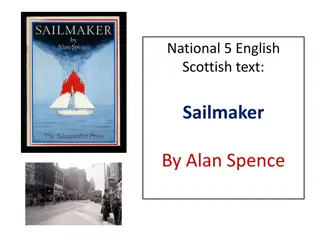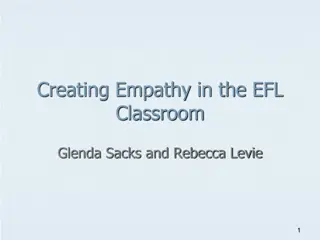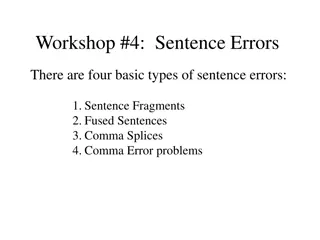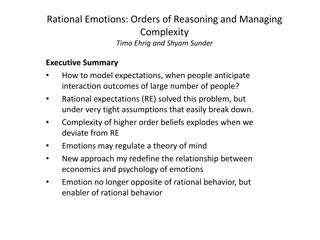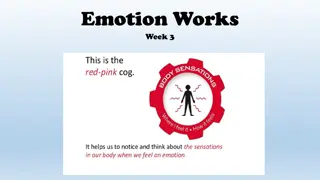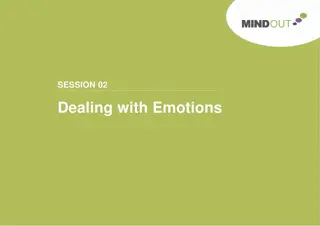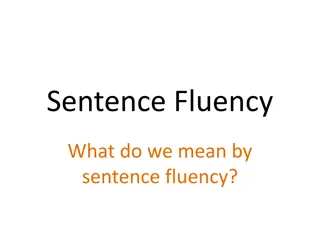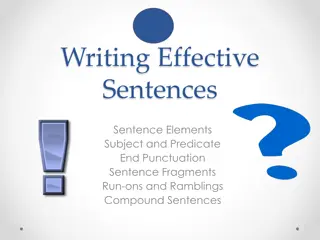Exploring Characters' Emotions Through Sentence Forms
Discover the impact of sentence forms on conveying characters' emotions. Explore principles linking grammar with meaning, authentic text examples, and discussions on textual patterns to understand characters' feelings in a literary context.
Download Presentation

Please find below an Image/Link to download the presentation.
The content on the website is provided AS IS for your information and personal use only. It may not be sold, licensed, or shared on other websites without obtaining consent from the author. Download presentation by click this link. If you encounter any issues during the download, it is possible that the publisher has removed the file from their server.
E N D
Presentation Transcript
Using different sentence forms to suggest characters emotions
LEAD Principles PRINCIPLE LINKS EXPLANATION RATIONALE To establish a purposeful learning reason for addressing grammar, and connect grammar with meaning and rhetorical effect Make a link between the grammar being introduced and how it works in the writing being taught To avoid writing lessons becoming mini- grammar lessons, and to allow access to the structure even if the grammar concept is not fully understood To integrate reading and writing and show how real writers make language choices EXAMPLES Explain the grammar through examples, not lengthy explanations AUTHENTIC TEXTS Use authentic texts as models to link writers to the broader community of writers To promote deep metalinguistic learning about why a particular choice works, and to develop independence rather than compliance DISCUSSION Build in high-quality discussion about grammar and its effects
Noticing Patterns in a Text Exclamations Hark! Questions Who lies in the second chamber? Statements A foolish thought, to say a sorry sight. I have done the deed. I heard the owl scream and the crickets cry. This is a sorry sight. Examples What, ho! Did not you speak? When? Minor Sentences Now. Didst thou not hear a noise? As I descended? Who s there? Donalbain. Ay. Discussion Read the text aloud in any order, paying attention to the punctuation to guide how you say the lines. What emotions can you hear in the characters voices? Which sentence type is the most frequently used? What might this suggest about the characters feelings?
Noticing Patterns in a Text Authentic text Hark! Who lies in the second chamber? Donalbain. This is a sorry sight. A foolish thought, to say a sorry sight. Who s there? What, ho! I have done the deed. Didst thou not hear a noise? I heard the owl scream and the crickets cry. Did not you speak? When? Now. As I descended? Ay. Discussion These are the original lines of dialogue but not yet in the right sequence. Can you work out which lines are spoken by Macbeth, and which lines by Lady Macbeth? Can you suggest the original sequence of the lines?
Noticing Patterns in a Text Authentic text Macbeth: Who s there? What, ho! I have done the deed. Didst thou not hear a noise? Lady Macbeth: I heard the owl scream and the crickets cry. Did not you speak? Macbeth: When? Lady Macbeth: Now. Macbeth: As I descended? Lady Macbeth: Ay. Macbeth: Hark! Who lies in the second chamber? Lady Macbeth: Donalbain. Macbeth: This is a sorry sight. Lady Macbeth: A foolish thought, to say a sorry sight. Discussion What is revealed about each character s emotions from the way they speak? From the way they speak to each other, what can you say about the relationship between Macbeth and Lady Macbeth at this point in the play? Links
Verbalising the Grammar-Writing Link A crucial element of the LEAD principles is helping writers to think explicitly (metalinguistically) about the choices they make. As a teacher, you need to support this by being crystal clear yourself about how you verbalise the link between a grammar choice and its effect in a particular text/context. Then express this in student-friendly language, as below. Verbalisation to share with students: When you are writing dialogue in narrative, you can think about how to show characters emotions. You might choose to use different sentence forms like statements, questions, exclamations and minor sentences (without a verb) to help you emphasise what a character is feeling.


